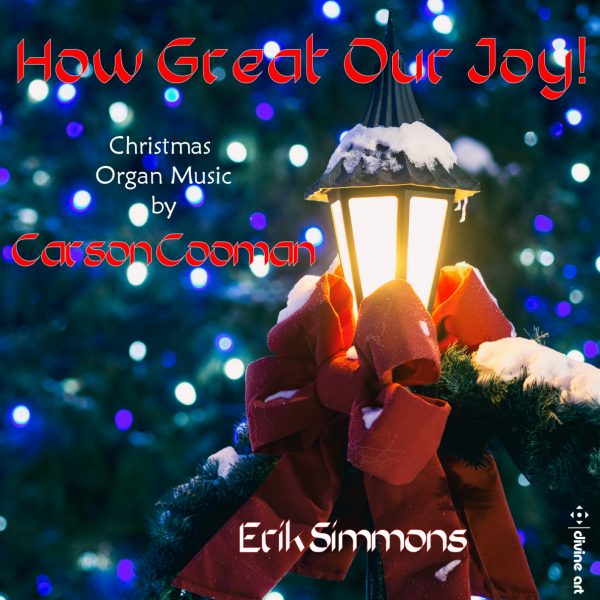Fanfare
This newly received item (titled Invocazione brillante) is the third disc of Carson Cooman’s organ music sent to me for review in this issue, and all three have shown the composer at his most felicitous. The works on this disc are consistently arranged in a pattern of a more dramatic or extrovert movement alternating with a quieter, more introverted one. The opening piece, Musica da processione, written for the wedding of Hartmann’s daughter, is an appropriately festive fanfare. Arioso is gentle and winning, lyric in the best vein of the verismo school. The dissonances that open the following Cortege, Intermezzo and Litany on the Joseph-Hymnus make for a jarring transition (perhaps the ordering of the pieces on the disc should have been different to avoid this). This work is one of three on the disc dedicated to Cooman’s friend and colleague, the organist and composer Andreas Willscher, whose recordings I have also reviewed in these pages, and employs the same theme that Willscher used in his own Fantasie über den Joseph-Hymnus. (Exactly what is the “Joseph-Hymnus” theme is nowhere identified.) The work is cast in three movements: the solemn opening procession, a lyric interlude akin to the Arioso, and the extroverted finale with its structure of proclamation and response. Romanza is curiously a bit off-kilter in its thematic material, with unexpectedly flattened intervals. Praeludium in festo S. Phillippi apostoli, the first of three works on this disc dedicated to the performer, employs the traditional plainchant melodies from that apostle’s feast day for its thematic basis and is suitably triumphal in mood, with an imitation of Sanctus bells at the close. Another work dedicated to Willscher, Diptych for New Life, is cast in two movements, titled “Aubade” and “Toccata.” The work draws its inspiration from the Canticle of the Sun by St. Francis of Assisi; Cooman states in his program notes that “As in many of my works, the sun is used as a metaphor for new life.” The first movement is peacefully contemplative, the second exuberant; I found this work, along with the Arioso, particularly attractive. Arioso cantabile returns to the vein of the preceding Arioso, and captures the stillness of lovely sunsets viewed from the islands of Sardinia and Nantucket, MA.
The Suite in F Major, dedicated to Hartmann, is another triptych. The opening “Praeludium” is stately and determined in tone; “Ground” treads with quiet deliberation, in accord with that appellation; “Fantasia” features exchanges between martial flourishes and more rapidly flowing material. The Prelude on “Das ist köstlich” (Psalm 92), the final work dedicated to Hartmann, is based on a 17th-century tune that recently gained greater fame as a setting for a paraphrase of Psalm 92 by the East German Lutheran pastor Günter Rutenborn (1912-1976), known for his widely translated theological drama The Sign of Jonah. This is a bit more assertive than the other “quiet” pieces on this disc. Invocazione brillante lives up to its nominal billing in its unbuttoned exuberance. Two Nantucket Sketches consists of a peaceful “Idyll” and a spirited, joyous “Danza rustica”; Lullaby is appropriately restful and soothing. The disc closes with another three-movement work, the Sonatina No. 4. Dedicated to Willscher, this is definitely an all-German affair, as can be seen from the movement titles: “Hamburg March,” “Pößneck Aria,” and “Ulm Toccata-Fanfare.” The somewhat broadly paced opening march segues into a lyrical interlude, wherein the melody is almost randomly punctuated by what sound like the toots of a ship’s whistle piercing early morning fog to signal river traffic, followed by the vibrant, assertive close.
To my knowledge, all previous Divine Art recordings of Cooman’s organ works were made with Cooman’s friend and colleague Erik Simmons, so this disc represents a change of pace in that regard. German organist Philip Hartmann, who has taken masterclasses with Daniel Roth and Ben van Oosten, here plays the instrument of his home parish, the Pauluskirche in Ulm in far south-central Germany. It is a fine instrument, and Hartmann is fully the equal of Simmons as a dedicated interpreter of Cooman’s music. The proceedings are well recorded; brief notes by Cooman, plus composer and artist bios and complete instrumental specifications, are provided in an English-German booklet. If you already are a fan of Cooman’s music, you will definitely want to add this latest entry to your collection. For those not familiar with him, this or the CD of Christmas-themed music I review elsewhere in this issue provide the most enticing entrees into his oeuvre to date; enthusiastically recommended.
@divineartrecordingsgroup
A First Inversion Company
Registered Office:
176-178 Pontefract Road, Cudworth, Barnsley S72 8BE
+44 1226 596703
Fort Worth, TX 76110
+1.682.233.4978












